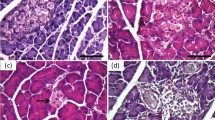Summary
Superoxide dismutase (SOD) is a free-radical scavenger present in B cells. It is thought to be responsible for protection against the autoimmune processes that characterize type I diabetes mellitus. Streptozocin (STZ) has been used as a low-dose treatment (LDS) to induce diabetes in animal models.
The aim of this study was to follow the islet SOD levels in a day-to-day study after an LDS treatment with STZ, 40 mg/kg body wt/d in C57BL6/J mice. Results reveal a progressive SOD decrease in pancreatic islets with increasing periods from the LDS treatment. This SOD decrease starts from the end of the STZ administration (d 5). In addition, it was noticed that glycemia starts to rise when SOD values have already reached their lowest levels. This indicates that a reduction of free-radical defense is a prerequisite for further cellular injuries. Furthermore, a difference was noticed between males and females: only 40% of female mice underwent a SOD decrement and an increase in glycemia, indicating an androgendependent mechanism.
Similar content being viewed by others
References
Asayama K, English D, Slonim AE, and Burr IM. Chemioluminescence as an index of drug-induced free radical production in pancreatic islets. Diabetes 1984; 33: 160–163.
Ruddle NH. Tumor necrosis factor and related cytotoxins. Immunol. Today 1987; 8: 129, 130.
Asayama K, Kooy NW, and Burr IM. Effect of vitamin E deficiency and selenium deficiency on insulin secretory reserve and free radical scavenging systems in islets: decrease of islet manganosuperoxide dismutase. J. Lab. Clin. Med. 1986; 107: 459–464.
Pisanti FA, Frascatore S, Papaccio G. Superoxide dismutase activity in the BB rat: a dynamic time-course study. Life Sci. 1988; 43: 1625–1632.
Malaisse WJ, Malaisse-Lagae F, Sener A, and Pipeleers DG. Determinants of the selective toxicity of alloxan to the pancreatic B cell. Proc. Natl. Acad. Sci. 1982; 79: 927–930.
Crouch RK, Gandy SE, Kimsey G, Galbraith RA, Galbraith GMP, and Buse MG. The inhibition of islet superoxide dismutase by diabetogenic drugs. Diabetes 1981; 30: 235–241
Robbins MJ, Sharp RA, Slonim AE, and Burr IM. Protection against streptozocininduced diabetes by superoxide-dismutase. Diabetologia 1980; 18: 55–58.
Gandy SE, Buse MG, and Crouch RK. Protective role of superoxide dismutase against diabetogenic drugs. J. Clin. Invest. 1982; 70: 650–658.
Fridovich I. Superoxide dismutase. Annu. Rev. Biochem. 1975; 44: 147–159.
Papaccio G, Pisanti FA, and Frascatore S. Acetyl-homocysteine-thiolactone induced increased superoxide-dismutase counteracts the effects of subdiabetogenic doses of streptozocin. Diabetes 1986; 35: 470–474.
Sumoski W, Baquerizo H, and Rabinovitch A. Oxygen free radical scavengers protect rat islet cells from damage by cytokines. Diabetologia 1989; 3: 792–796.
Nukatsuka N, Sakurai H, Yoshimura Y, Nishida M, and Kawada J. Enhancement by Streptozocin of O2-radical generation by the xanthine oxydase system of pancreatic B-cells. FEBS Lett 1988; 239: 295–298.
Papaccio G. Prevention of low dose streptozocin induced diabetes by acetyl-homocysteinethiolactone. Diab. Res. 1991, in press.
Like AA, and Rossini AA. Streptozocin induced pancreatic insulitis: new model of diabetes mellitus. Science 1976; 133: 415–417.
Papaccio G and Mezzogiorno V. Morphological aspects of glucagon and somatostatin islet cells in diabetic Bio Breeding and low dose streptozocin treated Wistar rats. Pancreas 1989; 4: 289–294.
Lacy PE and Kostianowski M. Method for the isolation of intact islets of Langerhans from the rat pancreas. Diabetes 1967; 16: 35–39.
Grankvist K, Marklund SL, and Taljedal IB. CuZn-superoxide dismustase, Mn-superoxide dismutase, catalase and glutathione peroxidase in pancreatic islets and other tissues in the mouse. Biochem. J. 1981; 199: 393–398.
Lowry OH, Rosebrough NJ, Farr AL, and Randall RJ. Protein measurement with the Folin Phenol reagent. J. Biol. Chem. 1951; 193: 265–275.
Marklund S and Marklund G. Involvement of the superoxide anion radical in the autoxidation of pyrogallol and a convenient assay for superoxide dismutase. Eur. J. Biochem. 1974; 47: 469–474.
Rossini AA, Williams RM, Appel MC, and Like AA. Sex differences in the multiple-dose streptozocin model of diabetes. Endocrinology 1978; 103: 1518–1520.
Gutteridge JMC. Superoxide dismutase and free radicals in clinical chemistry. Ann. Clin. Biochem. 1976; 13: 393–398.
Nomikos IN, Wang Y, and Lafferty KJ. Involvement of O2 radicals in ‘autoimmune’ diabetes. Immunol. Cell Biol. 1989; 67: 85–87.
Mendola J, Wright JR, and Lacy PE. Oxygen free-radical scavengers and immune destruction of murine islets in allograft rejection and multiple low-dose streptozocininduced insulitis. Diabetes 1989; 38: 379–385.
Kantwerk G, Cobbold S, Waldman H, Kolb H. L3T4 and Lyt-2 T cells are both involved in the generation of low-dose-streptozocin induced diabetes in mice. Clin. Exp. Immunol. 1986; 70: 585–592.
Fantose JC and Ward PA. Role of oxygen-derived free radicals and metabolites in leukocyte-dependent inflammatory reactions. Am. J. Pathol. 1982; 107: 395–418.
Mandrup-Poulsen T, Bendtzen K, Nerup J, Dinarello CA, Svenson M, and Nielsen JH. Affinity-purified human interleukin-1 is cytotoxic to isolated islets of Langerhans. Diabetologia 1986; 29: 63–67.
Author information
Authors and Affiliations
Rights and permissions
About this article
Cite this article
Papaccio, G., Latronico, M., Frascatore, S. et al. Superoxide dismutase in low-dose-streptozocin-treated mice. Int J Pancreatol 10, 253–260 (1991). https://doi.org/10.1007/BF02924163
Received:
Revised:
Accepted:
Issue Date:
DOI: https://doi.org/10.1007/BF02924163




